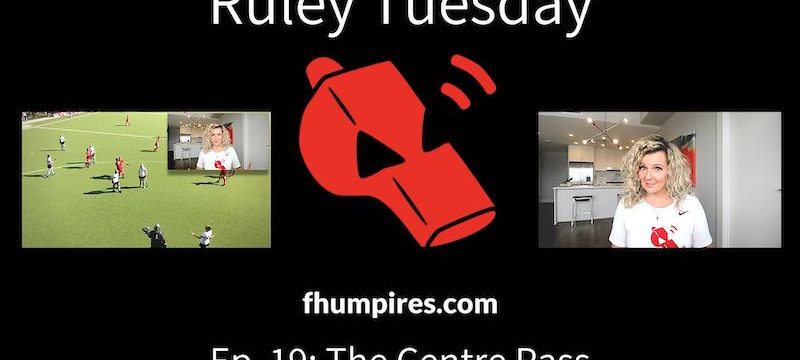A silky-smooth centre pass is the key to getting play started right. Get all the details here on this episode of #RuleyTuesday!
Transcript
Seriously at sea when setting up the centre pass? How about we soothe your suspicions so play in your matches starts smoothly. Let’s do this!
Hey friends! I’m Keely of FHumpires, and I invite you to settle in for our latest hot take on one hockey rule. Thanks to Robert Turnbull, we’re going to sort out a rule we don’t think much about: the centre pass.

Rules 6.3 and 6.4 – The Centre Pass
The rules governing the centre pass are super-simple:
6.3 A centre pass is taken:
a) to start the match and to start the second quarter by a player from the team winning the toss if they chose this option; otherwise by a player from the opposing team
b) to re-start the match after half-time and to start the fourth quarter by a player of the team which did not take the centre pass to start the match
c) after a goal by a player of the team against which the goal was scored.
6.4 Taking a centre pass:
a) taken at the centre of the field
b) it is permitted to play the ball in any direction
c) all players other than the player taking the centre pass must be in the half of the field which includes the goal they are defending
d) the procedures for taking a free hit apply.
Promoting Pro-activity
As with every set piece in our game, being proactive is the best way to make sure these go off without a hitch. When they’re being used to start play at the beginning of a time period (the half or the quarter, if you play those), it’s a lot easier to take your time to ensure the opposition has started the required 5m away from the ball. No time is ticking off the clock so there’s no excuse to not take this great opportunity to step in and firmly but kindly set your standards.
If your local competition doesn’t stop time after goals are scored, as most don’t, you may slip up a little on these restarts. Our tendency is to relax when a goal is scored because we think we finally get a few seconds where we don’t have to make any decisions. Just the opposite, friends: we must stay sharp and watch for angry reactions by the team scored upon, dick moves by the team who did score, attempts to waste time by whichever team might want to, and finally, silliness on the centre pass.
Time-Wasting at the Centre Pass
Here are two examples of managing time-wasting around the centre pass. In this clip, the team scored upon wants to have a little huddle to gather themselves, but unlike in international televised matches where time is stopped for 40s to allow for replays to be shown, there is no time stoppage here. The supporting umpire ends up intervening to make sure the team trying to continue their comeback don’t lose time off the clock or suffer a break in the momentum.
In our next clip, the team scored on also struggles to restart play, in part because a few players are continuing to argue with the controlling umpire about the goal that had been scored. When they ignore the whistle to play the centre pass and the clear verbal urgings from the umpire just in case the whistle wasn’t clear enough, he stops time, and then reverses the centre pass.
This is a risky step late very late in a close game. I think the sounder invervention is to stop time as soon as possible to prevent the time-wasting from having any affect, and then to card the captain for the misconduct. Keep everything calm, use the stopped clock to your advantage and get your message across clearly to all the players, and then restart play only when everything is settled.
Off-Side at the Centre Pass
Lastly, if an opposing player breaches sub (c) and sneaks out of the half they are defending before the ball has been played and gains advantage from doing so, it’s an easy free hit against, like we see here.
Ideally, you reset the sneaky sprinter before the ball gets played, just as you would as an early management step for a 5m infringement as the game has gotten going. If you can’t and the infringement doesn’t impact on the play, you would continue, but have a word with either the captain or the player involved at an opportune moment—a good one is as the teams are coming back out after their quarter or half-time break and are getting ready to do it all over again.
Did this #RuleyTuesday sort out this set piece to your satisfaction? Speak your sense in the comments and replies, and seek out the like button to sanction this session. Registration is open for only another 5 days for our next “Player-Proof Your PCs” workshop, so don’t sleep on your sign-up! Scurry over to fhumpires.com/workshops soon and remember: fhu3t members get super special dispensations. Survey your situation at fhu3t.com, I’m certain I’ll see you shortly!
Chau for now!
#tuesdaytip #hockey #fieldhockey #hockeyumpire #fieldhockeyumpire #rules #umpirelife #thirdteam #FIH #FIHumpire #rulesofhockey #rulesoffieldhockey #hockeyumpiring #fieldhockeyumpiring

Leave a Reply
You must be logged in to post a comment.